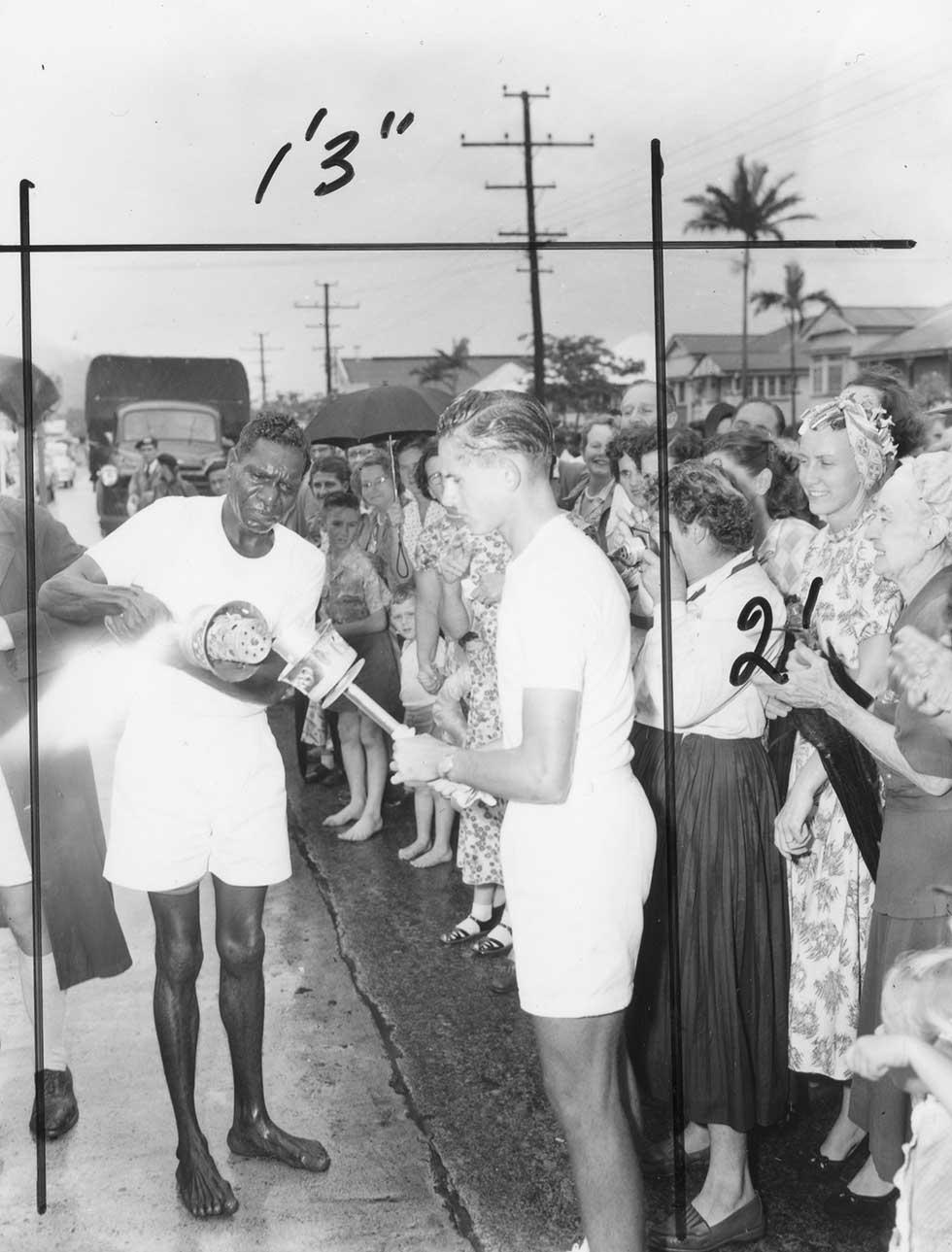


About this record
This black-and-white photograph shows the Olympic flame being passed from the torch of Anthony Mark – the second runner in the Australian leg of the torch relay – to that of another runner in Cairns, north Queensland, on 9 November 1956. The photograph shows the surrounding crowd and a support truck in the background. It is marked with imperial measurements, 1 foot, 3 inches (38 centimetres) x 2 feet (61 centimetres), and ruled lines to indicate where it should be cropped and a new image taken from the negative.
Educational value
- This photograph depicts the second and third runners in the contingent of 3118 young runners who took part in the 1956 Olympic torch relay, carrying the flame from Cairns to Melbourne, running day and night and covering the 4554-kilometre route in little more than 13 days. The 1956 relay was the longest to date in Olympic Games history and drew enthusiastic crowds along the route (in the daylight hours at least).
- Although symbolism entered into the allocation of some runners to particular segments of the relay – the first runner was Con Verevis, of Greek-born parents, acknowledging the origin of the Games – all were selected for their athletic ability and fitness. Anthony Mark, for example, was a well-known sportsman from the Kowanyama community in western Cape York. Each torch bearer had a mile (1.6 kilometres) to cover and the runners were only allowed six to seven minutes each, so they really had to run.
- Unlike recent torch relays in which there is a separate torch for each segment, for the 1956 relay there were only 110 torches made and each had to be re-used many times. After the runners completed their leg, they gave their torch to the attendant in the truck behind who doused the flame, removed the burnt fuel canister, and cleaned and refuelled the torch for further use. Designed by Ralph Lavers, the 1956 relay torches were 47 centimetres long and weighed 960 grams.
- The choice of Cairns as the starting point of the Olympic flame's journey down the eastern coast of Australia was the result of strenuous lobbying by the local municipal council. The Olympic flame had been kindled on the morning of 2 November at Olympia in Greece, travelled to Darwin by Qantas and was conveyed from Darwin to Cairns in a Royal Australian Air Force jet bomber. In recognition of the council's role, the city's mayor lit the first torch.
- The support vehicles moving ahead and behind each runner were supplied by Holden. More than two years before the relay, Holden had realised the commercial opportunity the event could provide to promote the new-look FE sedan due for release in mid-1956. Five FE cars were provided for the relay and Holden dealers along the route refuelled, serviced, repaired and cleaned them. The FE sedan following Mark is obscured in this photograph.
- Before image-editing software was available, a photograph was straightened, resized or cropped manually. Cropping lines and measurements were marked on a developed photograph to guide the photographer in chemically developing a new image from the negative in the dark room. In this case it seems the photographer was intending to develop a large image focusing on the two runners, perhaps a poster.
Acknowledgments
Learning resource text © Education Services Australia Limited and the National Archives of Australia 2010.
Related themes
Need help with your research?
Learn how to interpret primary sources, use our collection and more.




